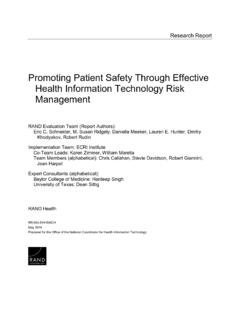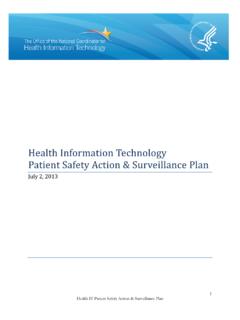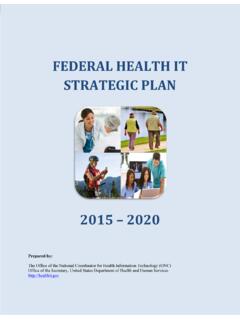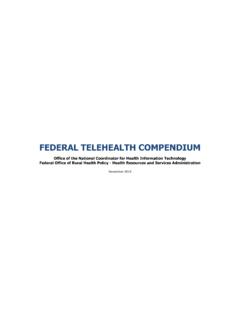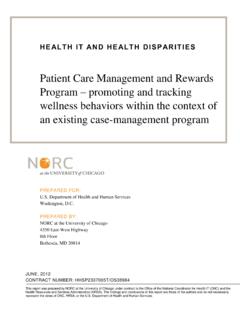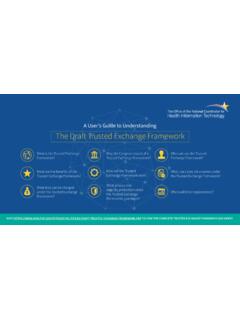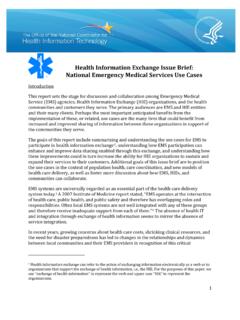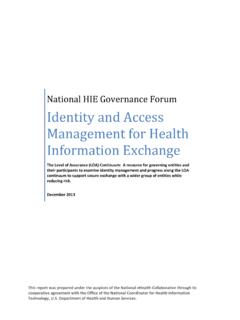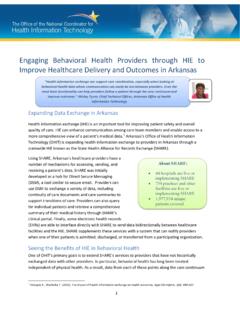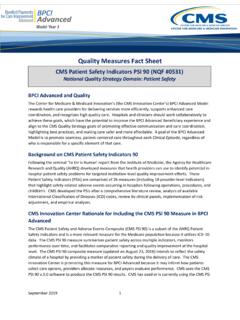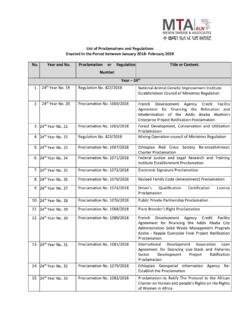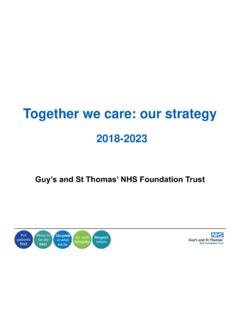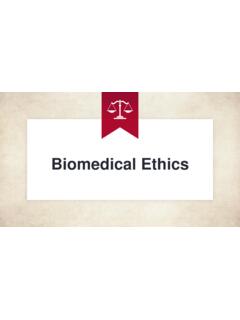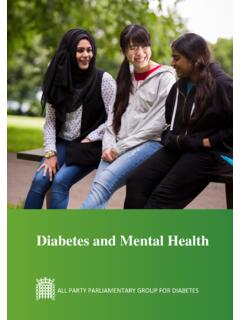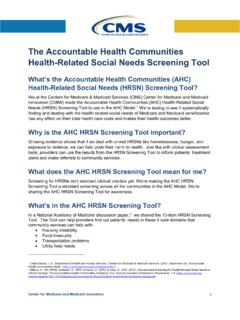Transcription of Optimizing Strategies for CLINICAL DECISION SUPPORT
1 The Learning Health System Series Optimizing Strategies for CLINICAL . DECISION . SUPPORT . Summary of a Meeting Series James E. Tcheng; Suzanne Bakken; David W. Bates; Hugh Bonner III;. Tejal K. Gandhi; Meredith Josephs; Kensaku Kawamoto; Edwin A. Lomotan;. Erin Mackay; Blackford Middleton; Jonathan M. Teich; Scott Weingarten;. Marianne Hamilton Lopez, Editors WA SH I NGTON, DC. NA DU. NAT IONA L AC A DE M Y OF M E DIC I N E 5 0 0 F I F T H S T R E E T, N W WA S H I NG T ON , D C 2 0 0 01. NOTICE: This publication has undergone peer review according to procedures established by the National Academy of medicine (NAM). Publication by the NAM signifies that it is the product of a carefully considered process and is a useful contribution worthy of public attention, but does not represent formal endorsement of conclusions and recommendations by the NAM. The views presented in this publication are those of individual authors and do not represent formal consensus positions of the NAM, the National Academies of Sciences, Engineering, and medicine , or the authors' organizations.
2 SUPPORT for this publication was provided by the Office of the National Coordinator for Health Information Technology. Library of Congress Cataloging-in-Publication Data Names: Tcheng, James E., editor. | National Academy of medicine ( ), issuing body. | Optimizing Strategies for CLINICAL DECISION SUPPORT (Meeting) (2016-2017 : Washington, ). Title: Optimizing Strategies for CLINICAL DECISION SUPPORT : summary of a meeting series / James E. Tcheng [and 12 others], editors. Description: Washington, DC : National Academy of medicine , [2017] | Series: The learning health system series | Includes bibliographical references. |. Identifiers: LCCN 2017055006 (print) | LCCN 2017056753 (ebook) | ISBN. 9781947103092 (Ebook) | ISBN 9781947103085 (pbk.). Subjects: | MESH: DECISION SUPPORT Systems, CLINICAL | CLINICAL DECISION -Making | Medical Informatics | Congresses Classification: LCC R858 (ebook) | LCC R858 (print) | NLM W | DDC. LC record available at Copyright 2017 by the National Academy of Sciences.
3 All rights reserved. Printed in the United States of America. Suggested citation: Tcheng, J. E., S. Bakken, D. W. Bates, H. Bonner III, T. K. Gandhi, M. Josephs, K. Kawamoto, E. A. Lomotan, E. Mackay, B. Middleton, J. M. Teich, S. Weingarten, and M. Hamilton Lopez, editors. 2017. Optimizing Strategies for CLINICAL DECISION SUPPORT : Summary of a Meeting Series. Washington, DC: National Academy of medicine . Knowing is not enough; we must apply. Willing is not enough; we must do.. G oethe LEADERSHIP. INNOVATION. I M PA C T. for a healthier future A BOUT THE NATIONA L ACA DEM Y OF medicine . The National Academy of medicine is one of three Academies constituting the National Academies of Sciences, Engineering, and medicine (the National Academies). The National Academies provide independent, objective analysis and advice to the nation and conduct other activities to solve complex problems and inform public policy decisions. The National Academies also encourage education and research, recognize outstanding contributions to knowledge, and increase public understanding in matters of science, engineering, and medicine .
4 The National Academy of Sciences was established in 1863 by an Act of Congress, signed by President Lincoln, as a private, nongovernmental institu . tion to advise the nation on issues related to science and technology. Members are elected by their peers for outstanding contributions to research. Dr. Marcia McNutt is president. The National Academy of Engineering was established in 1964 under the charter of the National Academy of Sciences to bring the practices of engineer . ing to advising the nation. Members are elected by their peers for extraordinary contributions to engineering. Dr. C. D. Mote, Jr., is president. The National Academy of medicine (formerly the Institute of medicine ). was established in 1970 under the charter of the National Academy of Sciences to advise the nation on issues of health, medical care, and biomedical science and technology. Members are elected by their peers for distinguished contributions to medicine and health.
5 Dr. Victor J. Dzau is president. Learn more about the National Academy of medicine at v STEER ING COMMIT TEE. JAMES E. TCHENG, MD, FACC, FSCAI, FSEC, Duke University School of medicine (Chair). SUZANNE BAKKEN, PhD, RN, FAAN, FACMI, Columbia University EDWIN A. LOMOTAN, MD, FAAP, Agency for Healthcare Research and Quality DAVID W. BATES, MD, MSc, Brigham and Women's Hospital ERIN MACKAY, MPH, National Partnership for Women & Families HUGH BONNER III, MD, Saint Francis Healthcare TEJAL K. GANDHI, MD, MPH, CPPS, National Patient Safety Foundation JONATHAN TEICH, MD, PhD, Brigham and Women's Hospital, Harvard University MEREDITH JOSEPHS, MD, MPH, FAAFP, Privia Health SCOTT WEINGARTEN, MD, MPH, Cedars-Sinai Health System NAM Staff Development of this publication was facilitated by contributions of the fol . lowing NAM staff, under the guidance of Michael McGinnis, MD, MPP, NAM. Leonard D. Schaeffer Executive Officer and Executive Director of the Leadership Consortium for a Value & Science-Driven Health System: MARIANNE HAMILTON LOPEZ, PhD, MPA, Senior Program Officer and Project Director MICHELLE JOHNSTON-FLEECE, MPH, Senior Program Officer VANANH VO, Senior Program Assistant, after November 2016.
6 ROSHEEN BIRDIE, Senior Program Assistant, until September 2016. LAURA DeSTEFANO, Director of Communications KYRA E. CAPPELUCCI, Communications Specialist MOLLY DOYLE, Communications Specialist Consultant JOE ALPER, rapporteur vii R EV IEWER S. T his special publication was reviewed in draft form by individuals chosen for their diverse perspectives and technical expertise, in accordance with review procedures established by the National Academy of medicine . We wish to thank the following individuals for their review of this publication: ANDREW BAZEMORE, MD, MPH, Robert Graham Center, American Academy of Family Physicians JONATHAN B. PERLIN, MD, PhD, MSHA, MACP, FACMI, HCA. (Hospital Corporation of America). ADAM WRIGHT, PhD, FACMI, Harvard Medical School and Brigham and Women's Hospital Although the reviewers listed above provided many constructive comments and suggestions, they were not asked to endorse the content of the publication, nor did they see the final draft before it was published.
7 Review of this publication was overseen by Marianne Hamilton Lopez, PhD, MPA, Senior Program Officer, NAM; and Michael McGinnis, MD, MPP, Leonard D. Schaeffer Executive Officer, NAM. Responsibility for the final content of this publication rests entirely with the editors and the NAM. ix ACK NOW LEDGMENTS. We would like to thank Daniel Bearss with the National Academies of Sciences, Engineering, and medicine for contributing to the development of this publica . tion through fact-checking assistance. xi CONTENTS. Acronyms and Abbreviations .. xv 1 CLINICAL DECISION SUPPORT .. 1. Challenges to CLINICAL DECISION Making.. 1. CLINICAL DECISION SUPPORT Concepts .. 2. Status and Barriers .. 4. NAM-ONC Project on CDS Strategies .. 5. Common Themes and Priorities .. 10. References .. 12. 2 Laying the CDS Foundation Stones .. 15. A Roadmap for National Action on CDS .. 15. The CDS Consortium .. 17. Structuring Care Recommendations for CDS.
8 17. CLINICAL Practice Guidelines.. 18. HIMSS CDS101 .. 19. AHRQ PCOR CDS Initiative .. 20. Summary of Key Issues .. 23. References .. 23. 3 Priorities for Accelerating CDS Progress .. 27. Creating, Managing, and Curating Content .. 28. Learning from CDS Implementation .. 32. Practical Strategies for Embedding CDS .. 35. Explicating the CDS Value Proposition .. 40. References .. 44. 4 Agenda for CDS Adoption and Use .. 45. Develop,Test, Establish,Validate, and Apply Standards .. 46. Encourage Delivery System Adoption, Use, and Assessment.. 47. Establish a National CDS Infrastructure .. 50. Moving Ahead .. 51. xiii xiv | Optimizing Strategies for CLINICAL DECISION SUPPORT APPENDIXES. A Meeting Series Agendas .. 53. B Meeting Series Participants .. 63. C Editor Biographies .. 71. ACRON YMS A ND A BBR EV IATIONS. AFA Analytic Framework for Action AHRQ Agency for Healthcare Research and Quality AMIA American Medical Informatics Association API application program interface APMs alternative payment models CDS CLINICAL DECISION SUPPORT CDSC CLINICAL DECISION SUPPORT Consortium CHIME College of Healthcare Information Management Executives CMS Centers for Medicare and Medicaid Services CPG CLINICAL practice guidelines EHR electronic health record FDA Food and Drug Administration FHIR Fast Healthcare Interoperability Resources HFMA Healthcare Financial Management Association HHS Department of Health and Human Services HIMSS Healthcare Information and Management Systems Society HITECH Health Information Technology for Economic and CLINICAL Health Act HL7 Health Level Seven international standards ICER Institute for CLINICAL and Economic Review IHI Institute for Healthcare Improvement IOM Institute of medicine ISMP Institute for Safe
9 Medication Practices IT information technology xv xvi | Optimizing Strategies for CLINICAL DECISION SUPPORT MACRA Medicare Access and CHIP Reauthorization Act MRI magnetic resonance imaging NAM National Academy of medicine NASEM The National Academies of Sciences, Engineering, and medicine NCQA The National Committee for Quality Assurance NQF National Quality Forum ONC Office of the National Coordinator for Health Information Technology PCOR patient-centered outcomes research PCORI Patient-Centered Outcomes Research Institute PSOs patient safety organizations 1. CLINICA L DECISION SUPPORT . Challenges to CLINICAL DECISION Making F acilitative CLINICAL DECISION SUPPORT (CDS) is a practical necessity for every clinician in our rapidly evolving health and healthcare landscape. A central promise of health information technology (health IT) within the learning health system is its potential to ameliorate the burden that exponentially expanding CLINICAL knowledge as well as care and choice complexity place on the finite time and attention of clinicians, patients, and every other member of the care team.
10 Realizing this promise demands that health IT deliver the right information, at the right point and format within the DECISION and care processes to optimize outcomes by consistently applying the best available knowledge in context of every patient's needs and goals. Delivering information this way to all patients and care teams, routinely and at pace with our expanding knowledge, in turn demands shared and sustainable solutions. These solutions must be collaboratively developed across affected stakeholders to address key challenges and exponentially accelerate the availability of reliably curated information resources that are readily, affordably, and seamlessly incorporated with patient-centered, clinician-friendly workflows via interoperable health IT systems and patient data. A continuously learning health system is driven by the seamless and rapid generation, processing, and practical application of the best available evidence for the circumstance.
